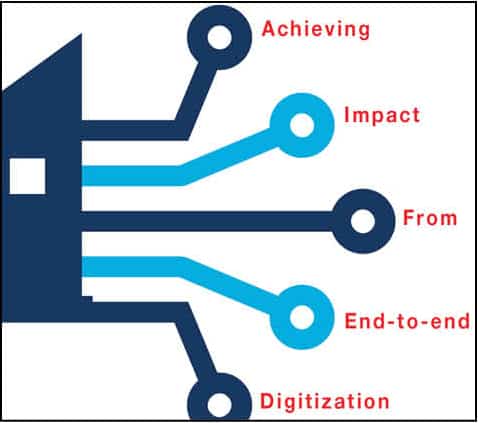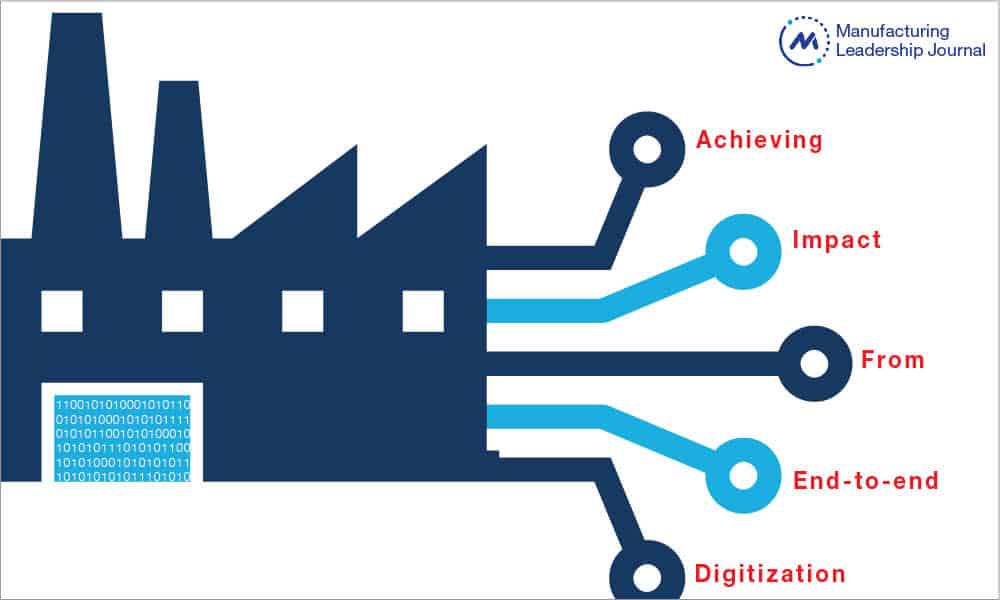Achieving Impact from End-to-End Digitalization
Setting a clear business case and conditions for success helps companies take incremental steps to deliver transformational value.

Manufacturers are under unprecedented pressure to produce high quality, low-cost products at pace. Compounded by the complexities of resource scarcity, complicated supply chains, and mounting legislation, efficiency is everything. The solution? Manufacturing 4.0 (M4.0), otherwise known as Smart Manufacturing.
M4.0 is regarded as the next industrial revolution and refers to the powerful combination of technological innovation, changing operational strategies, and new ways of working. At the heart of M4.0, and fuelling the transformation of the manufacturing sector, is digitization. Every transformative technology driving M4.0 relies on careful and programmatic digital integration. Bringing these technologies into existing models is proving to be an iterative process with a distant horizon. However, incremental steps, when done carefully, can deliver significant value.
The Devil’s in the Data
Technologies like robotics, 5G connectivity, Machine Learning (ML), and Artificial Intelligence (AI) provide access to valuable data that can streamline and accelerate material-efficient design and enable revolutionary digital production methods. Digital twin technology heralds the arrival of the metaverse in manufacturing, virtually representing existing functions such as production lines to help businesses assess the impact of specific scenarios without pausing processes or compromising safety.
Data is difficult to use in these scenarios without the right tools in place. It is typically fragmented, isolated, and can be ‘dirtied’ by a lack of data governance within organizations. With 73 percent of all data collected floating unused in the digital ether, it is no wonder that businesses struggle to maximize the value of their digital assets.

“To identify the most impactful technology, focus on where you have operational challenges or gaps in accurate and accessible information needed to make better business decisions. ”
Data is often localized in a range of systems along the operations planning, operations management, and operations execution landscape. These systems include ERP (Enterprise Resource Planning), MRP (Material Resource Planning), MES (Manufacturing Execution System), SCADA (supervisory control and data acquisition), for example. Integration of these trapped data sets, combined with basic analytics capability, can deliver important insights to key areas of efficiency leakage like quality; however, companies often struggle to justify the investment in data itself, without clear demonstratable business cases.
Other opportunities like low-capex solutions such as connected sensors – measuring vibration, temperature, vision, and more – may help to diagnose manufacturing operations issues and provide a tangible example of the M4.0 value proposition. For example, a vibration sensor may be calibrated to monitor and record machine cycles, detecting production disruption and correlating to machine failure to provide the basis for predictive maintenance capability. This maintenance event and resulting machine downtime can be integrated into the production schedule, which in turn can be connected to customer facing capabilities like Available to Promise (ATP) and Capable to Promise (CTP) that help drive revenue. These connected capabilities, enabled by M4.0 technologies, help drive quantitative improvements.
Manufacturers can also incorporate third-party data, such as trading party transactional information, to gain greater oversight of the end-to-end supply chain. Better visibility leads to improved risk management while pre-empting disruption and anticipating opportunities. Procter and Gamble, for example, uses digital twin technology to check product quality in real-time directly on the production line, maximizing equipment resiliency while optimizing energy and water use to avoid waste.
How to Get Started
The investment required to drive M4.0 cannot be justified in a simple manner. It is impossible to do it all at once, but is manageable when broken down into smaller pieces. The most effective way to do this is through a defined, carefully timed and executed roadmap.
Start by understanding what information is required to diagnose, anticipate, or report issues, and ultimately what is the desired outcome. This might be addressing the causes of production disruption, such as quality issues, safety, or obstructed views of planning or execution. Then, break down your strategy. What iterative steps need to be taken to solve the situation? What role will technology play in providing data where there are gaps? What is the most effective M4.0 method for your problem? Unilever, for example, is currently implementing a new digital roadmap fueled by automation at one of their largest ice cream factories in Caivano, Italy. The ambition is to free workers from repetitive, routine work, allowing them to upskill while reducing operating costs and improving the safety and efficiency of the factory.

“Avoid moving forward with a specific technology for technology’s sake, only pursuing the opportunities that will deliver real, measurable value.”
To identify the most impactful technology, focus on where you have operational challenges or gaps in accurate and accessible information needed to make better business decisions. This includes internal observation, but also looking outside of your organization at how competitors and partners navigate digital opportunities. Next, define your key focus areas and identify the gnarliest questions. Answering these critical questions will bring the most value. Then, examine your existing processes and infrastructure. Can they integrate with more advanced systems? Can you run systems in parallel? What are the initial costs of integration and migration? Build a transformation framework into your roadmap, with key milestones. Consider key dependencies and potential impacts. Determine if external partners can play a role to advance the realization of benefits.
Build a Case for Change
You will then have defined your specific operations opportunity and created a roadmap to apply M4.0 technologies to these opportunities. Success now relies on two things: communication and unification. The entire organization needs to understand the processes you intend to embed, how, and most importantly, why. Clear, cross-department communication will help teams understand the opportunities that M4.0 will bring and recognize the rationale for digitization. Inspire your teams by creating a compelling case for change. Communication should include partners and suppliers, as they are likely to be impacted positively. Business alignment is vital. The process or technology you want to introduce should pursue a shared, overarching purpose.

“Manufacturing companies that understand the central role of data and its criticality to enabling value integration across people, process, and technology are leading the way in enterprise digitization.”
With full business and supply chain buy-in, and a clear rationale that reflects organizational objectives, you can move to the next stage. Test your chosen change, setting up pilots to assess the impact and finetune your approach. If you do not see the expected outcome, take a step back. Avoid moving forward with a specific technology for technology’s sake, only pursuing the opportunities that will deliver real, measurable value. At the height of the COVID-19 pandemic, for example, PA developed an AI enabled forecasting capability to predict 30-day forecasts of COVID-19 trends with 75 percent accuracy, supporting global manufacturing companies to manufacture and distribute their products in line amid demand fluctuations.
Nail Then Scale the Opportunity
The questions that often accompany significant developments, especially those requiring investment and a measured level of risk, are how quickly adoption will happen, and how easily will it scale? Our research into breakthrough innovation found that once a clear business case is made and the conditions for success are set, scalability will take care of itself.
Investment in M4.0 technologies provides greater visibility, aiding strategic and operational planning, and transforming reactive behavior into a predictive, proactive approach. Data-driven disruption in manufacturing improves order management, production monitoring, predictive maintenance, resource management, and inventory optimization, all while supporting cohesive feedback loops between sales, marketing, and manufacturing teams. The benefits are clear, bringing significant improvements that increase quality, efficiency, profitability, and customer satisfaction.
Manufacturing companies that understand the central role of data and its criticality to enabling value integration across people, process, and technology are leading the way in enterprise digitization. These outlier organizations are utilizing end-to-end digital integration to develop ‘shop floor to top floor’ capabilities, optimizing operations through better processes and people management. M
About the authors:

Michael Platz is a Supply Chain and Manufacturing Operations Expert at PA Consulting.

Shanton Wilcox is a Partner and America’s Leader in Manufacturing at PA Consulting.

